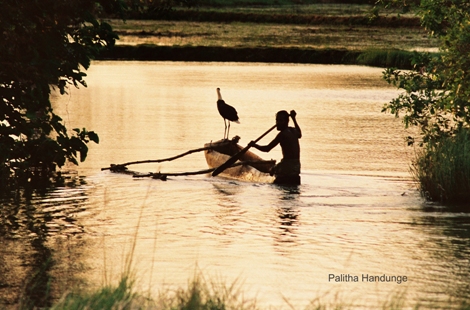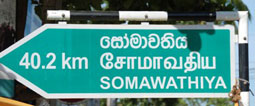Somawathie & Flood Plains National Parks
Somawathie and Flood Plains National Parks, and Trikonamadu Nature Reserve
Somawathie National Park
- Area: 378 km2
- Status: Established on 02 September 1986. It is contiguous to the east with the Trikonamdu Nature Reserve with an additional area of about 250 km2
- Main Entrance: Off Sungavilla Road coming from the Hospital Junction in Polonnaruwa town (A11).
- Travel time from PRS (monkey camp): 90 min
Geography and habitat: Flat deltaic floodplains of the Mahavelli river and its tributaries with many water bodies (villus) fed by seasonal flooding. The park is contiguous with the Trikonamdu Nature Reserve to the east, and with the Floodplains National Park to the south. The central riparian flood plains have many grasslands and marshes surrounding old river channels and villus. The vegetation is featured by a rich predominance of water tolerant grasses and aquatic plans. On higher ground, the dry evergreen forest cover extensive areas surrounding the water bodies, and riverine forests border the rivers. Large trees of kumbuk (Terminalia arjuna), mee (Madhuca longofilia), kon (Schleicheira oleosa), palu (Manilkara hexandra), halemba (Mitragyna parvifolia) grow in the moist soils, and extensive tracts of weera (Drypetes sepiara), satin (Chloroxylon swietenia), ebony (Diospyros ebenum), kunumella (Diospyros ovalifolia), and palu (Manilkara hexandra) in the drier soils.
History and culture: The Somawathie dagoba was built by queen Somawathie in the 2nd century BC and enshrines a tooth relic of the Buddha. The shrine was originally built on the eastern side of the Mahavelli river and was part of the Ruhuna kingdom, as described in the ancient literature, the Mahavamsa. Since that time, geomorphological changes have diverted the course of the river such that the shrine is now situated on the river’s western banks in the neighboring ancient kingdom of Rajaratha.

Wildlife: The flood plain marshes are rich with resident water birds and are important refuges for about 75 migrant species. Elephants are estimated at about 400 individuals in the park. Smaller herds congregate around numerous villus in the dry season (June to October). Other wildlife typical of the dry zone also is found here. See more
Flood Plains National Park
- Area: about 173 km2
- Status: Established 07 August 1984
- Main Entrance: none, but accessible off the Polonnaruwa Batticaloa Road (route A11)
- Travel time from PRS (monkey camp): 30 min
Geography and habitat: Flat, flood plains of the Mahavelli river, villu ecosystem, similar to Somawathie NP. The vegetation resembles that of a swampforest owed to periodic inundation, and the park is known for its many clumps of cane (Calamus rottang). Common trees are kumbuk (Terminalia arjuna), helumba (Mitragyna parvifolia), mee (Madhuca longifolia). The normal dry zone forest composition is found on higher ground. Riverine or gallery forests cover the riverbanks.
History and culture: The Dimbulagala monadnock rises tall (545 m) above the plains and is about 8 km from the park. The rock has several pre-historic caves, and an ancient (2nd Century BC) Buddhist temple is at its base. The park has several rock engravings from different eras. West of the park is the fortress, Vijithapura, famous for the bloodiest battle fought in ancient times.
 Wildlife: The park’s major attractions are its resident and migrant waterbirds. The migrant birds are best observed from October to March, during the rainy season. Elephants move through this area in their treks between Wasgamuwa NP and Somawathie NP, but access to areas of easy observation is underdeveloped. The normal compliment of dry zone animals is found here. See more
Wildlife: The park’s major attractions are its resident and migrant waterbirds. The migrant birds are best observed from October to March, during the rainy season. Elephants move through this area in their treks between Wasgamuwa NP and Somawathie NP, but access to areas of easy observation is underdeveloped. The normal compliment of dry zone animals is found here. See more


